door lock VOLKSWAGEN TRANSPORTER 1990 T4 / 4.G Owners Manual
[x] Cancel search | Manufacturer: VOLKSWAGEN, Model Year: 1990, Model line: TRANSPORTER, Model: VOLKSWAGEN TRANSPORTER 1990 T4 / 4.GPages: 165, PDF Size: 24.87 MB
Page 4 of 165
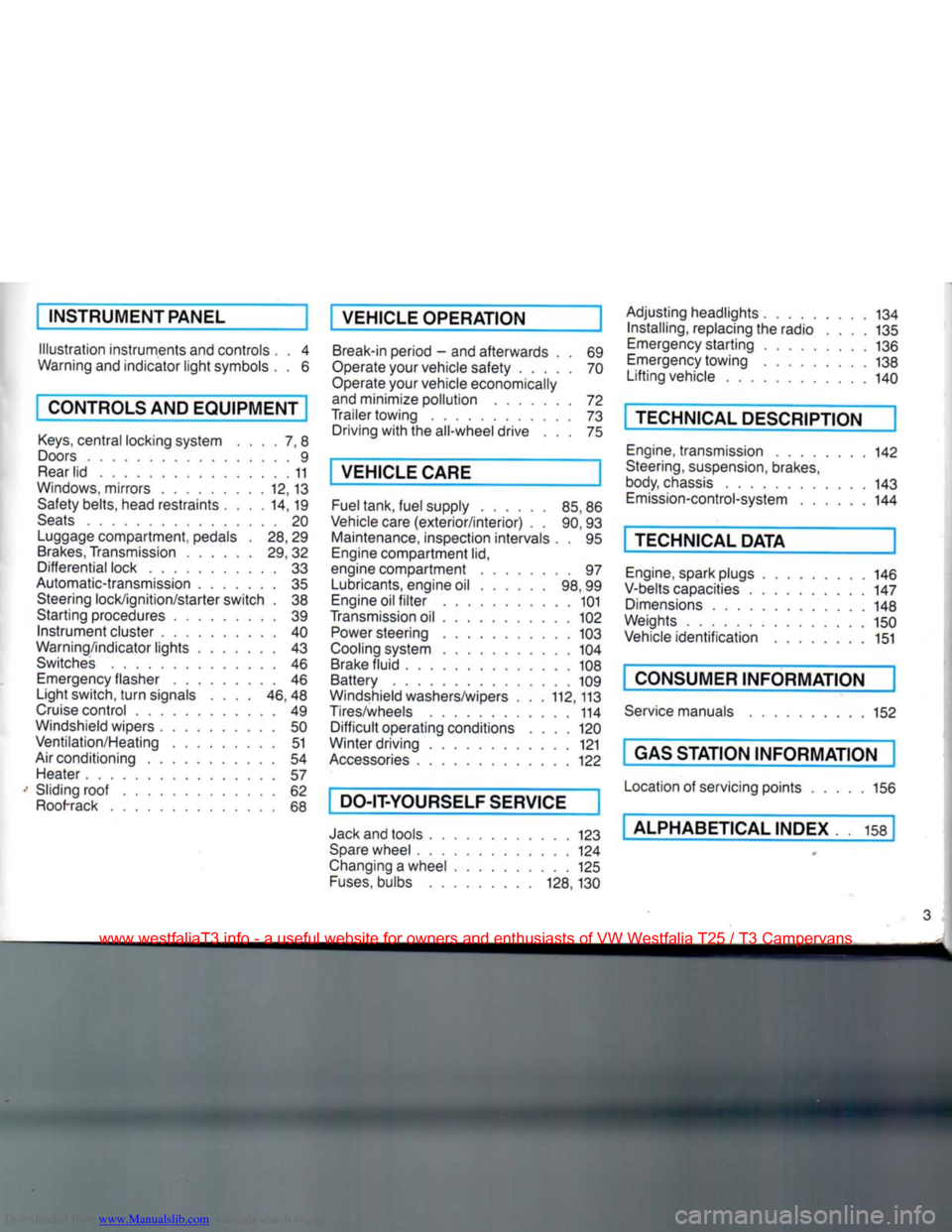
Downloaded from www.Manualslib.com manuals search engine
1
INSTRUMENT PANEL
Illustration instruments and controls
Warning and indicator light symbols
CONTROLS AND EQUIPMENT
Keys,
central locking system .... 7, 8
Doors 9
Rear lid 11
Windows, mirrors 12, 13 Safety belts, head restraints . . . .14,19
Seats 20 Luggage compartment, pedals . 28,29
Brakes, Transmission 29, 32 Differential lock 33
Automatic-transmission 35 Steering lock/ignition/starter switch . 38
Starting procedures 39 Instrument cluster 40
Warning/indicator lights 43 Switches 46 Emergency flasher 46
Light switch, turn signals .... 46,48
Cruise control 49
Windshield wipers 50 Ventilation/Heating 51
Air conditioning 54
Heater 57
Sliding roof 62
Roof-rack 68 VEHICLE OPERATION
Break-in period - and afterwards . . 69
Operate your vehicle safety 70
Operate your vehicle economically
and minimize pollution 72
Trailer towing 73 Driving with the all-wheel drive ... 75
VEHICLE CARE
Fuel tank, fuel supply 85,86
Vehicle care (exterior/interior) . . 90, 93 Maintenance, inspection intervals . . 95 Engine compartment lid,
engine compartment 97 Lubricants, engine oil 98,99
Engine oil filter 101
Transmission oil 102
Power steering 103
Cooling system 104 Brake fluid 108
Battery 109
Windshield washers/wipers . . . 112,113
Tires/wheels 114 Difficult operating conditions .... 120
Winter driving 121
Accessories 122
DO-IT-YOURSELF SERVICE
Jack and tools 123 Spare wheel 124
Changing a wheel 125 Fuses, bulbs 128, 130 Adjusting headlights
134
Installing,
replacing the radio . . . . 135
Emergency starting 136
Emergency towing 138
Lifting vehicle . . 140
TECHNICAL DESCRIPTION
Engine, transmission 142
Steering,
suspension, brakes,
body, chassis 143 Emission-control-system 144
TECHNICAL DATA
Engine, spark plugs .
V-belts capacities . . Dimensions
Weights
Vehicle identification 146
147
148
150 151
CONSUMER INFORMATION
Service manuals 152
GAS STATION INFORMATION
Location of servicing points 156
ALPHABETICAL INDEX 158
www.westfaliaT3.info - a useful website for owners and enthusiasts of VW Westfalia T25 / T3 Campervans
Page 8 of 165
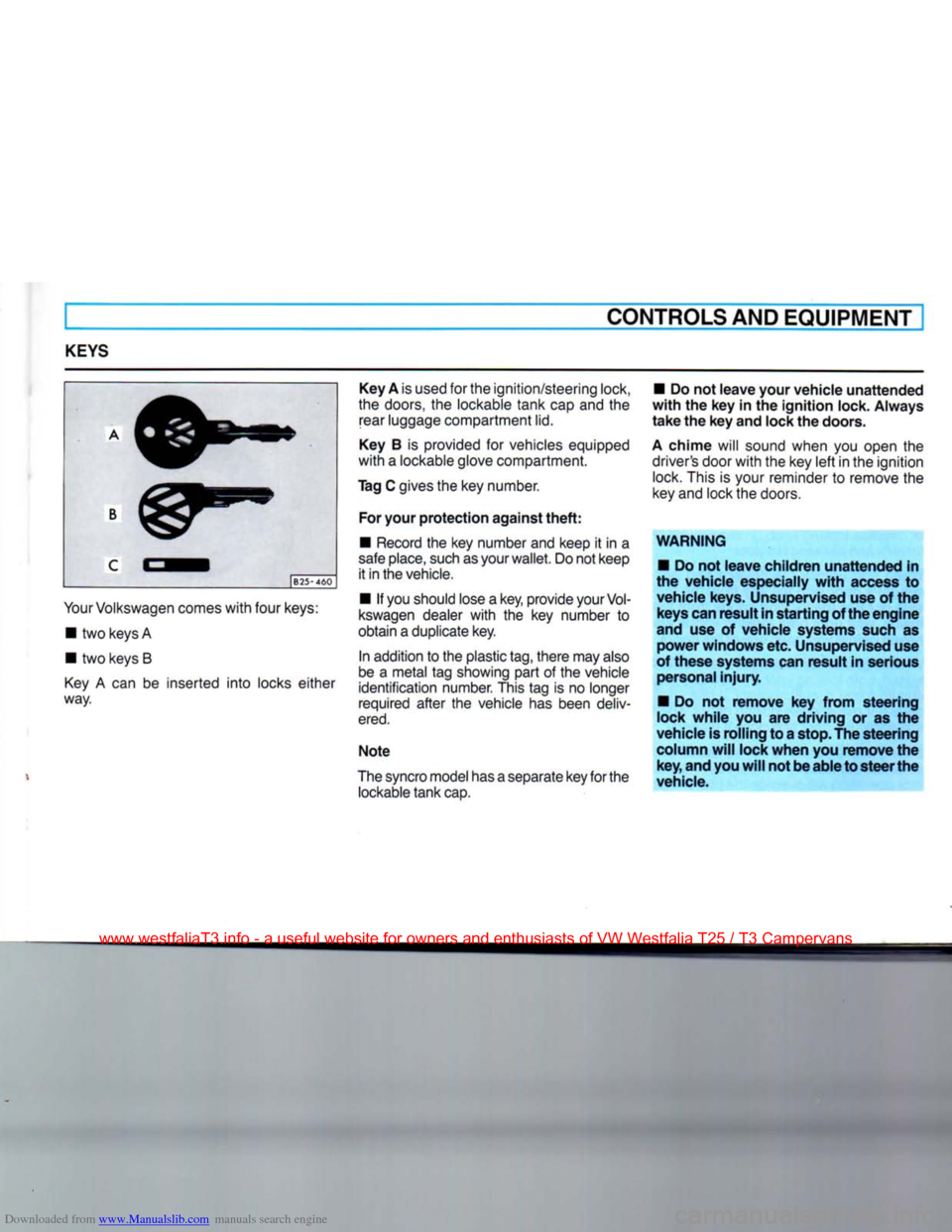
Downloaded from www.Manualslib.com manuals search engine
CONTROLS AND
EQUIPMENT
Key A is used for the ignition/steering lock, • Do not
leave
your
vehicle
unattended
the doors, the lockable tank cap and the
with
the key in the
ignition
lock.
Always
rear luggage compartment lid.
take
the key and lock the doors.
KEYS
B25-460
Your
Volkswagen comes
with
four keys: • two keys A
• two keys B
Key
A can be inserted
into
locks either
way. Key B is provided for vehicles equipped
with
a lockable glove compartment.
Tag C gives the key number.
For
your
protection
against
theft:
• Record the key number and keep it in a
safe
place, such as your wallet. Do not keep it in the vehicle.
• If you should lose a key, provide your
Vol
kswagen dealer
with
the key number to
obtain a duplicate key.
In addition to the plastic tag, there may also
be a metal tag snowing part of the vehicle
identification number. This tag is no longer
required after the vehicle has been deliv
ered.
Note
The syncro model has a separate key for the lockable tank cap.
A
chime
will sound when you open the
driver's door
with
the key
left
in the ignition lock. This is your reminder to remove the
key and lock the doors.
WARNING
• Do not
leave
children
unattended
in
the
vehicle
especially
with
access to
vehicle
keys. Unsupervised use of the
keys
can
result
in
starting
of the
engine
and use of
vehicle
systems such as
power
windows
etc. Unsupervised use
of
these
systems can
result
in serious
personal
injury.
• Do not
remove
key
from
steering
lock
while
you are
driving
or as the
vehicle
is
rolling
to a stop. The
steering
column
will
lock
when
you
remove
the key, and you
will
not be
able
to
steer
the
vehicle.
www.westfaliaT3.info - a useful website for owners and enthusiasts of VW Westfalia T25 / T3 Campervans
Page 9 of 165
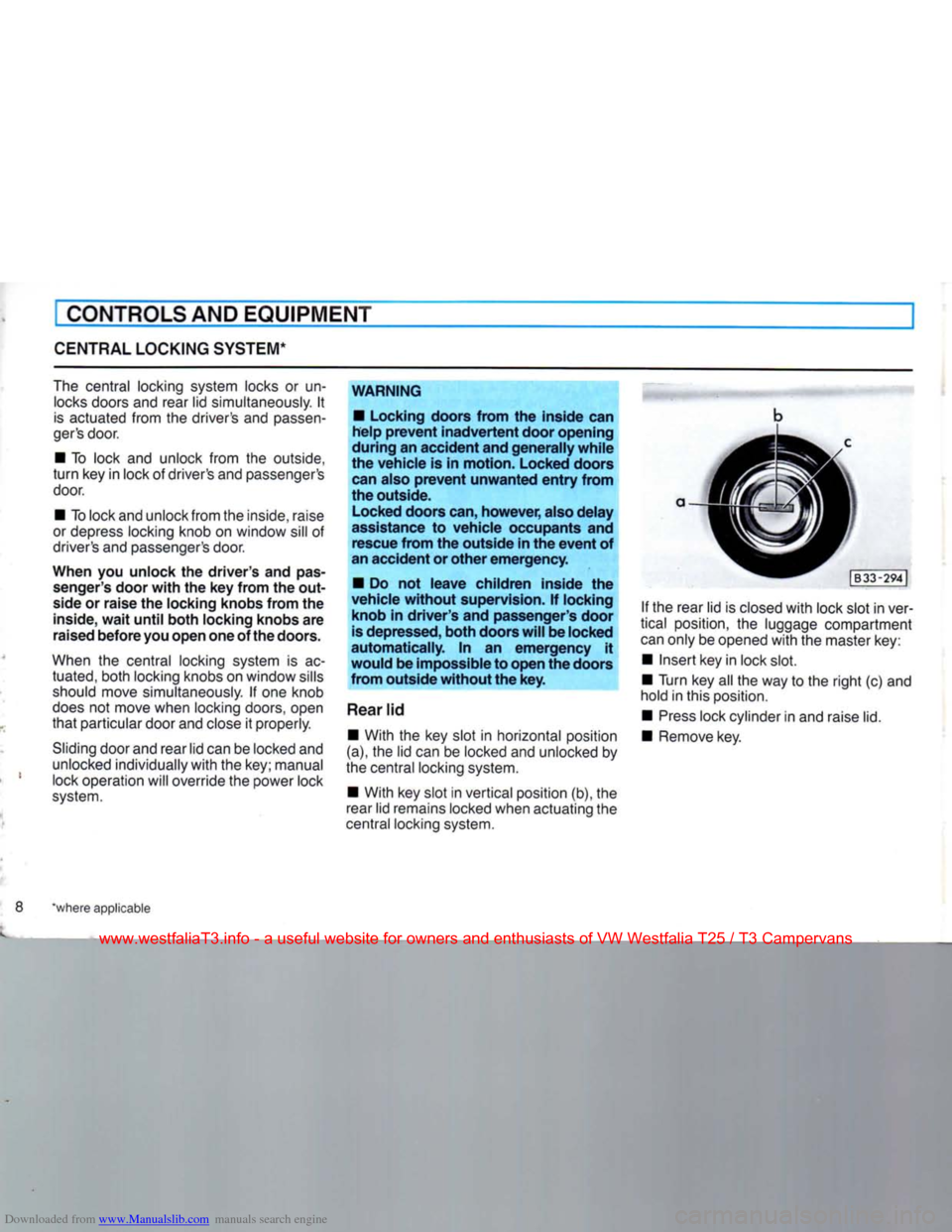
Downloaded from www.Manualslib.com manuals search engine
CONTROLS AND EQUIPMENT
CENTRAL
LOCKING SYSTEM*
The
central locking system locks or un
locks
doors and rear lid simultaneously. It
is
actuated from the driver's and
passen
ger's
door.
• To lock and unlock from the outside,
turn
key in lock of driver's and passenger's
door.
• To lock and unlock from the inside, raise
or depress locking knob on window sill of
driver's and passenger's door.
When
you unlock the
driver's
and pas senger's door
with
the key
from
the
out
side or
raise
the locking knobs
from
the inside,
wait
until
both
locking knobs are
raised
before
you open one of the doors.
When
the central locking system is ac tuated, both locking knobs on window sills
should
move simultaneously. If one knob
does
not move when locking doors, open
that
particular door and close it properly.
Sliding
door and rear lid can be locked and
unlocked
individually
with
the key; manual lock operation will override the power lock
system.
WARNING
• Locking doors
from
the inside can
help
prevent
inadvertent
door opening
during
an
accident
and
generally
while
the
vehicle
is in
motion.
Locked doors can also
prevent
unwanted
entry
from
the outside.
Locked doors can,
however,
also
delay
assistance to
vehicle
occupants and rescue
from
the
outside
in the
event
of
an
accident
or
other
emergency.
• Do not
leave
children
inside the
vehicle
without
supervision. If locking
knob
in
driver's
and passenger's door is depressed,
both
doors
will
be locked
automatically.
In an
emergency
it
would
be impossible to open the doors
from
outside
without
the key.
Rear
lid • With the key slot in horizontal position
(a), the lid can be locked and unlocked by
the central locking system.
• With key slot in vertical position (b), the
rear lid remains locked when actuating the
central locking system. If the rear lid is closed
with
lock slot in ver
tical position, the luggage compartment
can
only be opened
with
the master key:
• Insert key in lock slot.
• Turn key all the way to the
right
(c) and
hold in this position.
•
Press
lock cylinder in and raise lid.
• Remove key.
'where applicable
www.westfaliaT3.info - a useful website for owners and enthusiasts of VW Westfalia T25 / T3 Campervans
Page 10 of 165
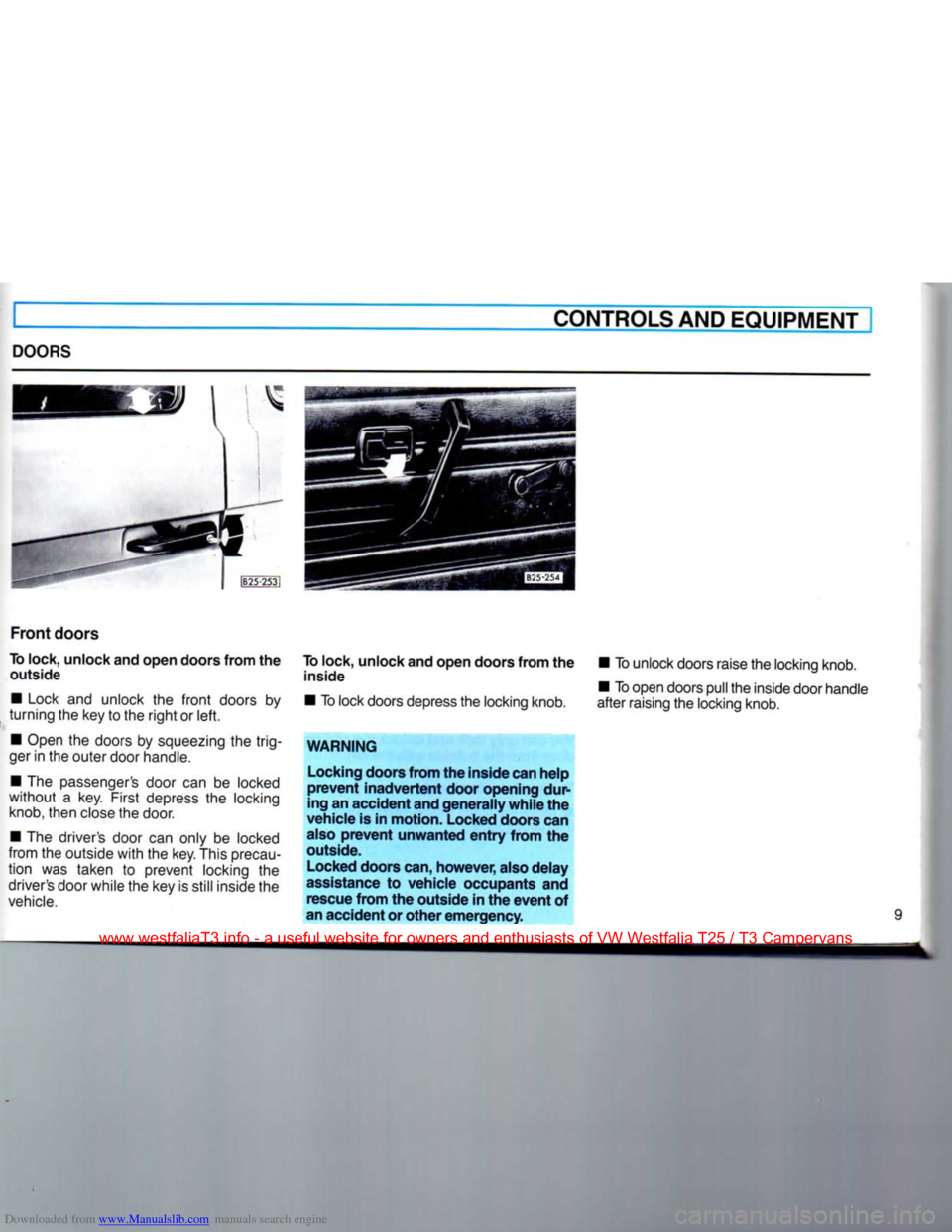
Downloaded from www.Manualslib.com manuals search engine
CONTROLS AND
EQUIPMENT
DOORS
Front
doors
To
lock, unlock and open doors from the outside
• Lock and unlock the
front
doors by
turning the key to the
right
or
left.
• Open the doors by squeezing the trig
ger in the outer door handle.
• The passenger's door can be locked
without
a key. First depress the locking knob, then close the door.
• The driver's door can only be locked
from the outside
with
the key. This precau
tion
was taken to prevent locking the driver's door while the key is still inside the
vehicle.
To
lock, unlock and open doors from the
inside
• To lock doors depress the locking knob.
WARNING
Locking doors
from
the
inside
can
help
prevent
inadvertent
door
opening
dur
ing an
accident
and
generally
while
the
vehicle
is in
motion.
Locked doors can
also
prevent
unwanted
entry
from
the
outside.
Locked doors can,
however,
also
delay
assistance to
vehicle
occupants and rescue
from
the
outside
in the
event
of
an
accident
or
other
emergency.
• To unlock doors raise the locking knob.
•
To
open doors pull the inside door handle
after raising the locking knob.
www.westfaliaT3.info - a useful website for owners and enthusiasts of VW Westfalia T25 / T3 Campervans
Page 11 of 165
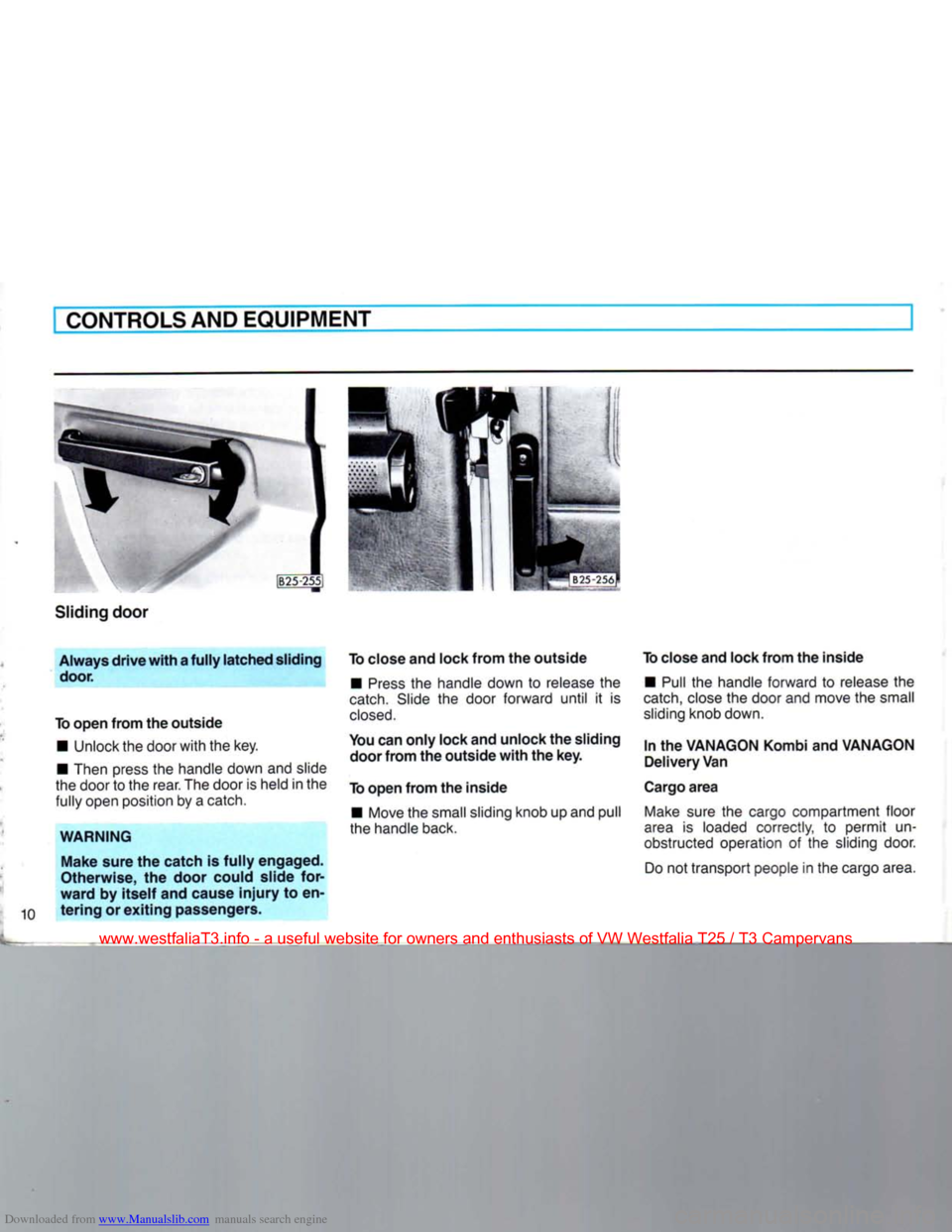
Downloaded from www.Manualslib.com manuals search engine
CONTROLS AND
EQUIPMENT
Sliding door
Always
drive
with
a
fully
latched
sliding door.
To
open
from
the
outside
• Unlock the door
with
the key.
• Then press the handle down and slide
the door to the rear. The door is held in the
fully open position by a catch.
WARNING
Make
sure
the
catch
is
fully
engaged.
Otherwise,
the door could slide
for
ward
by
itself
and cause
injury
to en
tering
or
exiting
passengers. To close and lock
from
the
outside
•
Press
the handle down to release the
catch.
Slide the door forward
until
it is
closed.
You can
only
lock and
unlock
the sliding door
from
the
outside
with
the key.
To
open
from
the
inside
• Move the small sliding knob up and pull
the handle back. To close and lock
from
the
inside
• Pull the handle forward to release the
catch,
close the door and move the small
sliding knob down.
In the VANAGON Kombi and VANAGON
Delivery
Van
Cargo
area
Make
sure the cargo compartment floor
area
is loaded correctly, to permit un
obstructed operation of the sliding door.
Do
not transport people in the cargo area.
www.westfaliaT3.info - a useful website for owners and enthusiasts of VW Westfalia T25 / T3 Campervans
Page 13 of 165
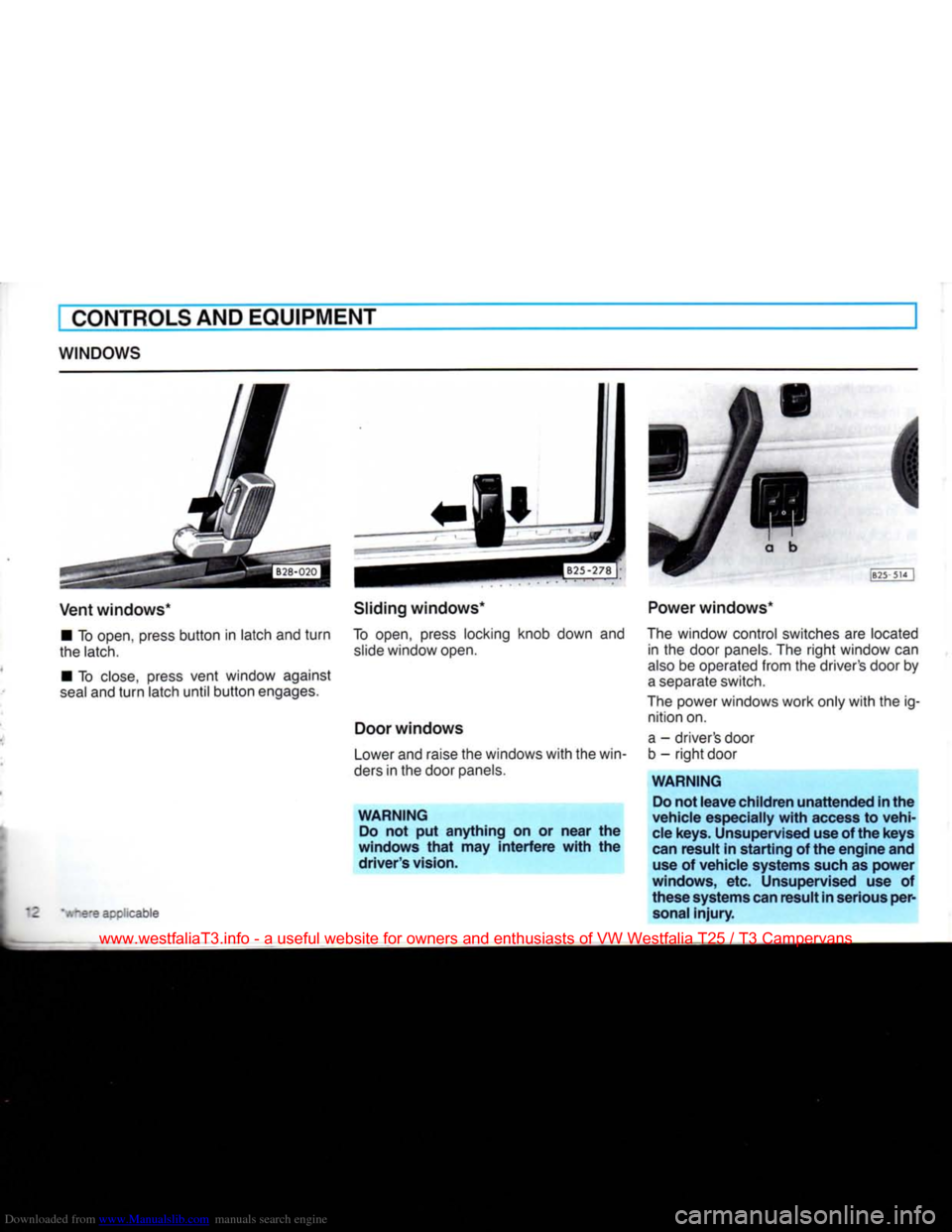
Downloaded from www.Manualslib.com manuals search engine
CONTROLS
AND EQUIPMENT
WINDOWS
Vent windows*
•
To
open,
press
button in latch and turn
the
latch.
•
To
close,
press
vent window
against
seal
and turn latch until button
engages.
Sliding
windows*
To
open,
press
locking
knob down and
slide
window
open.
Door
windows
Lower
and
raise
the windows with the
win
ders
in the
door
panels.
WARNING
Do
not put anything on or near the
windows
that
may
interfere
with
the driver's vision.
~s's
aco'icable
Power windows*
The
window control
switches
are
located
in
the
door
panels.
The right window can
also
be
operated
from the driver's
door
by
a
separate
switch.
The
power
windows work only with the ig
nition
on.
a
- driver's
door
b
- right
door
WARNING
Do
not leave children unattended in the
vehicle especially
with
access
to vehi
cle
keys. Unsupervised use of the keys
can
result in starting of the engine and
use
of vehicle systems such as power
windows, etc. Unsupervised use of
these systems can result in serious per
sonal
injury.
www.westfaliaT3.info - a useful website for owners and enthusiasts of VW Westfalia T25 / T3 Campervans
Page 15 of 165
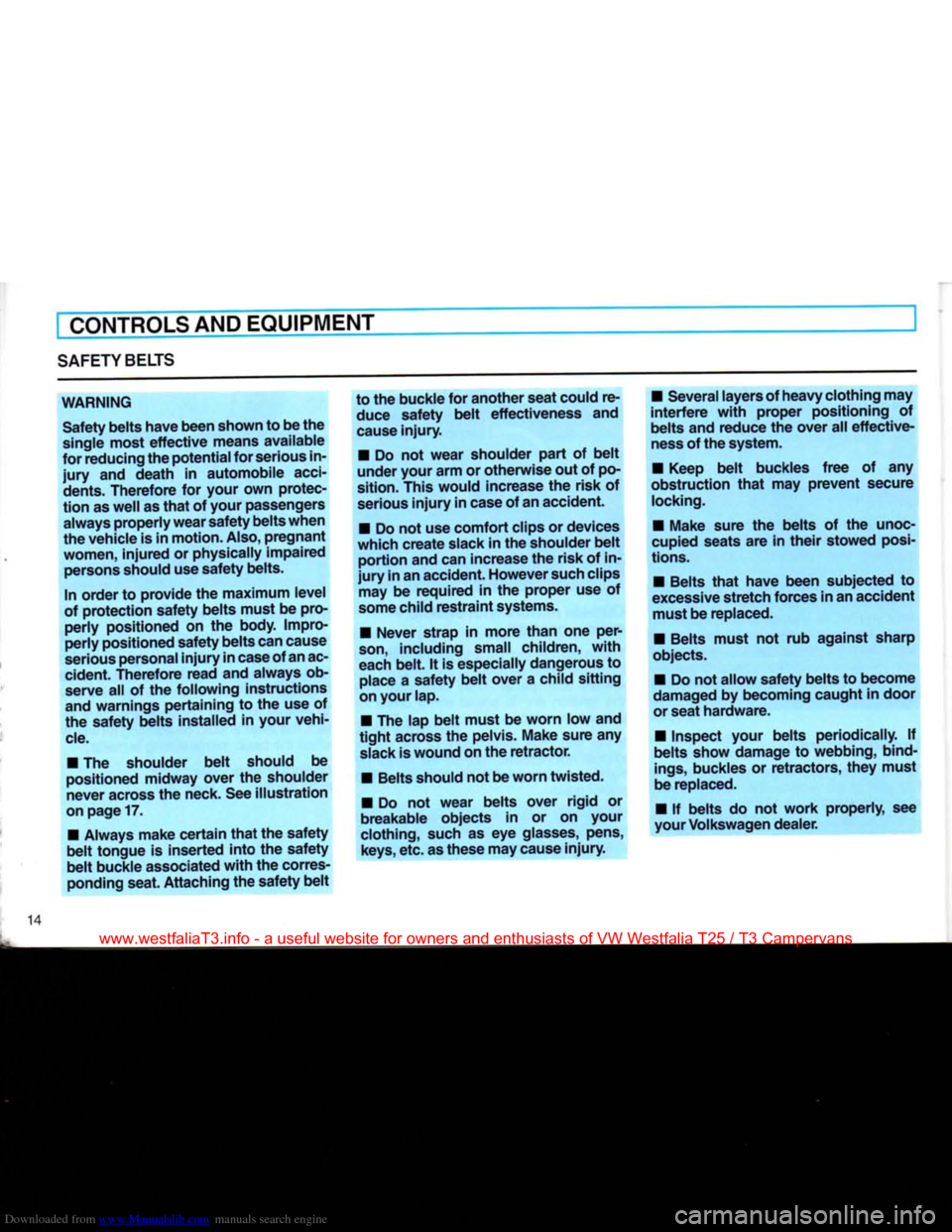
Downloaded from www.Manualslib.com manuals search engine
CONTROLS
AND
EQUIPMENT
SAFETY
BELTS
WARNING Safety belts have been shown to be the
single most effective means available
for reducing the
potential
for serious in
jury
and death in automobile
acci
dents.
Therefore
for
your
own protec
tion as well as that of
your
passengers always properly wear safety
belts
when
the vehicle is in
motion.
Also, pregnant
women,
injured or physically impaired persons should use safety belts.
In order to provide the maximum level
of protection safety belts must be pro perly positioned on the
body.
Impro
perly positioned safety belts
can
cause
serious personal
injury
in
case
of
an
ac
cident.
Therefore
read and always ob serve all of the following instructions
and warnings pertaining to the use of
the safety belts installed in
your
vehi
cle.
•
The shoulder belt should be
positioned midway
over
the shoulder
never
across the neck. See illustration
on page
17.
•
Always make certain that the safety
belt tongue is inserted into the safety
belt buckle associated with the corres
ponding seat. Attaching the safety belt to the buckle for another seat could re
duce safety belt effectiveness and
cause
injury.
•
Do not wear shoulder part of belt
under
your
arm
or otherwise out of po
sition.
This
would increase the risk of
serious
injury
in case of
an
accident.
•
Do not use comfort clips or devices
which create slack in the shoulder belt portion and can increase the risk of in
jury
in an accident.
However
such clips may be required in the proper use of
some
child restraint systems.
•
Never
strap in more than one per
son,
including
small
children, with
each
belt. It is especially dangerous to
place
a safety belt
over
a child sitting
on
your
lap.
•
The lap belt must be
worn
low and
tight across the pelvis. Make sure any
slack
is wound on the retractor.
•
Belts should not be
worn
twisted.
•
Do not wear belts
over
rigid or
breakable
objects in or on
your
clothing,
such as eye glasses, pens,
keys,
etc. as these may cause
injury.
•
Several layers of
heavy
clothing
may
interfere with proper positioning of
belts
and reduce the
over
all effective
ness
of the system.
•
Keep belt buckles free of any
obstruction that may
prevent
secure
locking.
•
Make sure the belts of the unoc
cupied seats are in their stowed posi
tions.
•
Belts that have been subjected to
excessive stretch forces in
an
accident must be replaced.
•
Belts must not rub against sharp
objects.
•
Do not allow safety belts to become
damaged
by becoming caught in door
or seat hardware.
•
Inspect
your
belts periodically. If
belts
show damage to webbing, bind
ings,
buckles or retractors,
they
must
be replaced.
•
If belts do not work properly, see
your
Volkswagen dealer.
www.westfaliaT3.info - a useful website for owners and enthusiasts of VW Westfalia T25 / T3 Campervans
Page 18 of 165
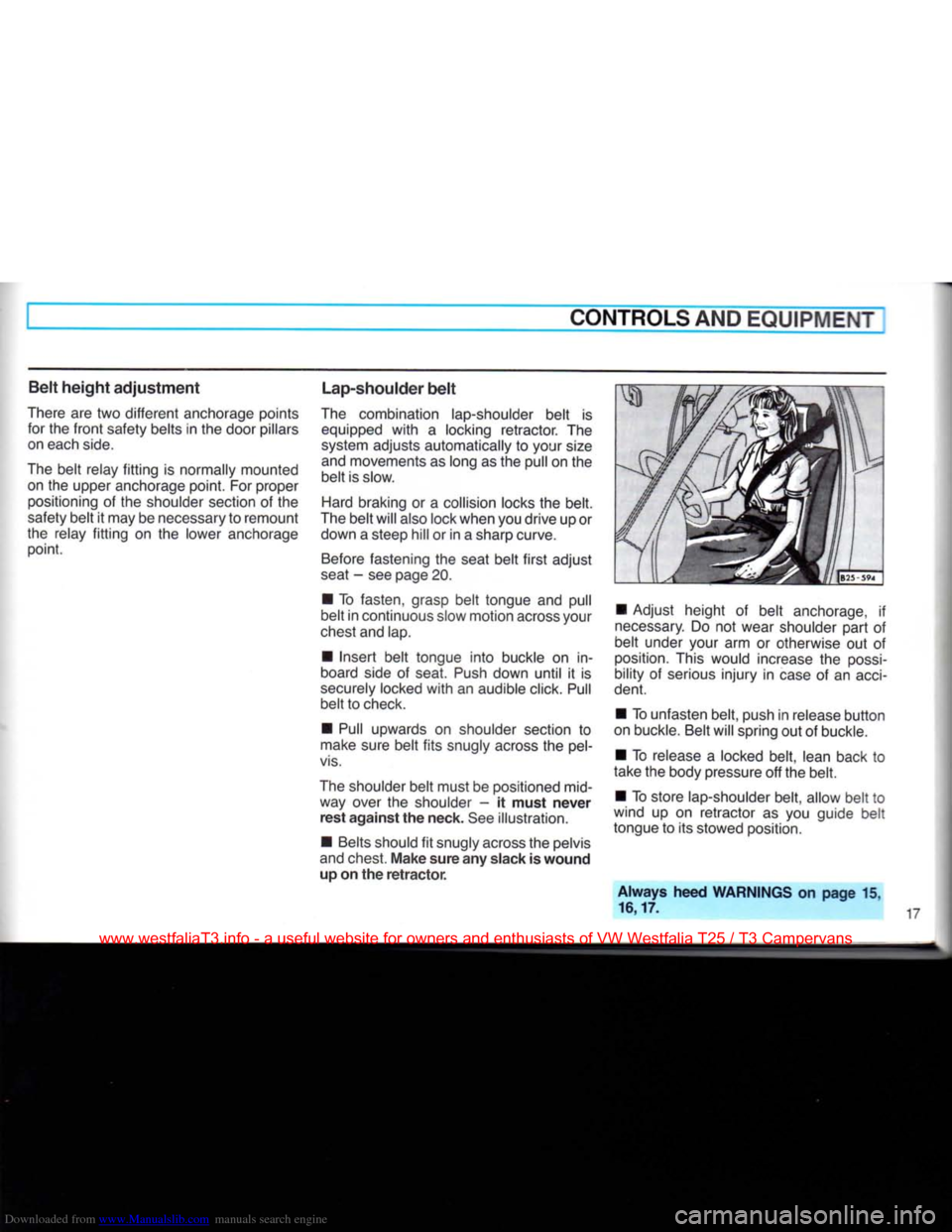
Downloaded from www.Manualslib.com manuals search engine
CONTROLS AND
EQUIPMENT
Belt
height
adjustment
There
are two different anchorage points for the
front
safety belts in the door pillars on each
side.
The
belt relay
fitting
is normally mounted on the upper anchorage point. For proper positioning of the shoulder section of the
safety belt it may be necessary to remount
the relay
fitting
on the lower anchorage point. Lap-shoulder
belt
The
combination lap-shoulder belt is equipped
with
a locking retractor. The
system
adjusts automatically to your
size
and
movements as long as the pull on the
belt is slow.
Hard
braking or a collision locks the belt.
The
belt will also lock when you drive up or down a steep hill or in a sharp curve.
Before
fastening the seat belt
first
adjust
seat
- see page 20.
• To fasten, grasp belt tongue and pull
belt in continuous slow motion across your
chest
and lap.
• Insert belt tongue into buckle on in
board side of seat.
Push
down until it is
securely
locked
with
an audible click.
Pull
belt to check.
•
Pull
upwards on shoulder section to
make
sure belt
fits
snugly across the
pel
vis.
The
shoulder belt must be positioned mid way over the shoulder - it
must
never
rest
against
the neck. See illustration.
• Belts should fit snugly across the pelvis
and
chest.
Make
sure any slack is
wound
up on the
retractor.
• Adjust height of belt anchorage, if
necessary.
Do not wear shoulder part of
belt under your arm or otherwise out of
position.
This would increase the
possi
bility of serious injury in
case
of an
acci
dent.
• To unfasten belt, push in release button
on buckle. Belt will spring out of buckle.
• To release a locked belt, lean back to
take the body pressure off the belt.
• To store lap-shoulder belt, allow belt to
wind up on retractor as you guide belt
tongue to its stowed position.
Always
heed
WARNINGS
on
page
15.
16,17.
www.westfaliaT3.info - a useful website for owners and enthusiasts of VW Westfalia T25 / T3 Campervans
Page 23 of 165
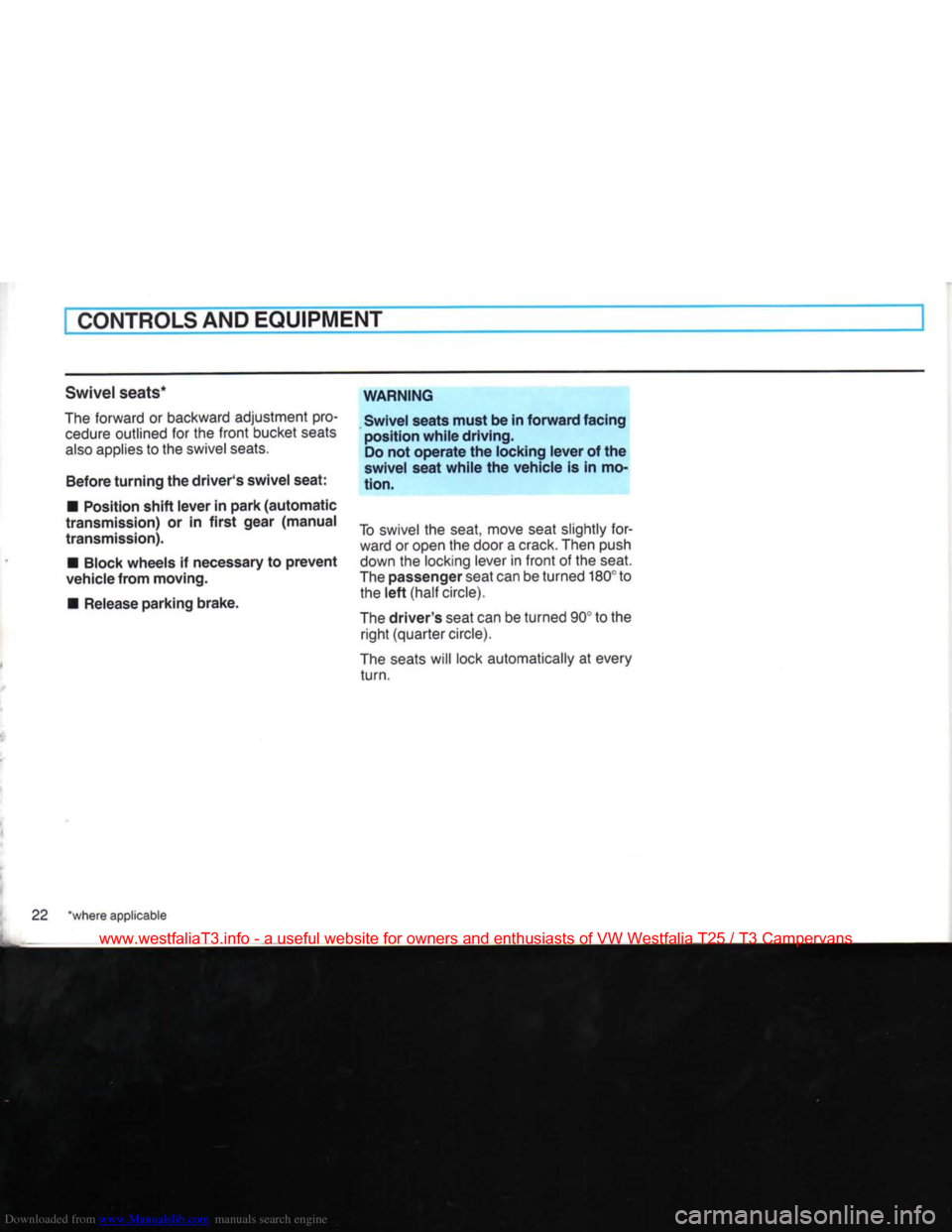
Downloaded from www.Manualslib.com manuals search engine
CONTROLS
AND
EQUIPMENT
Swivel seats*
The forward or backward adjustment pro cedure outlined for the
front
bucket seats
also
applies to the swivel seats.
Before turning the driver's swivel seat:
•
Position shift lever in park (automatic
transmission) or in first gear (manual
transmission).
•
Block wheels if necessary to
prevent
vehicle from moving.
•
Release parking brake. WARNING
Swivel seats must be in forward facing
position while driving. Do not operate the locking lever of the
swivel seat while the vehicle is in mo
tion.
To swivel the seat, move seat slightly for ward or open the door a crack.
Then
push
down the locking lever in
front
of the seat.
The passenger seat can be turned
180°
to the left
(half
circle).
The driver's seat can be turned
90°
to the
right
(quarter
circle).
The seats will lock automatically at
every
turn.
22
"where applicable
www.westfaliaT3.info - a useful website for owners and enthusiasts of VW Westfalia T25 / T3 Campervans
Page 24 of 165
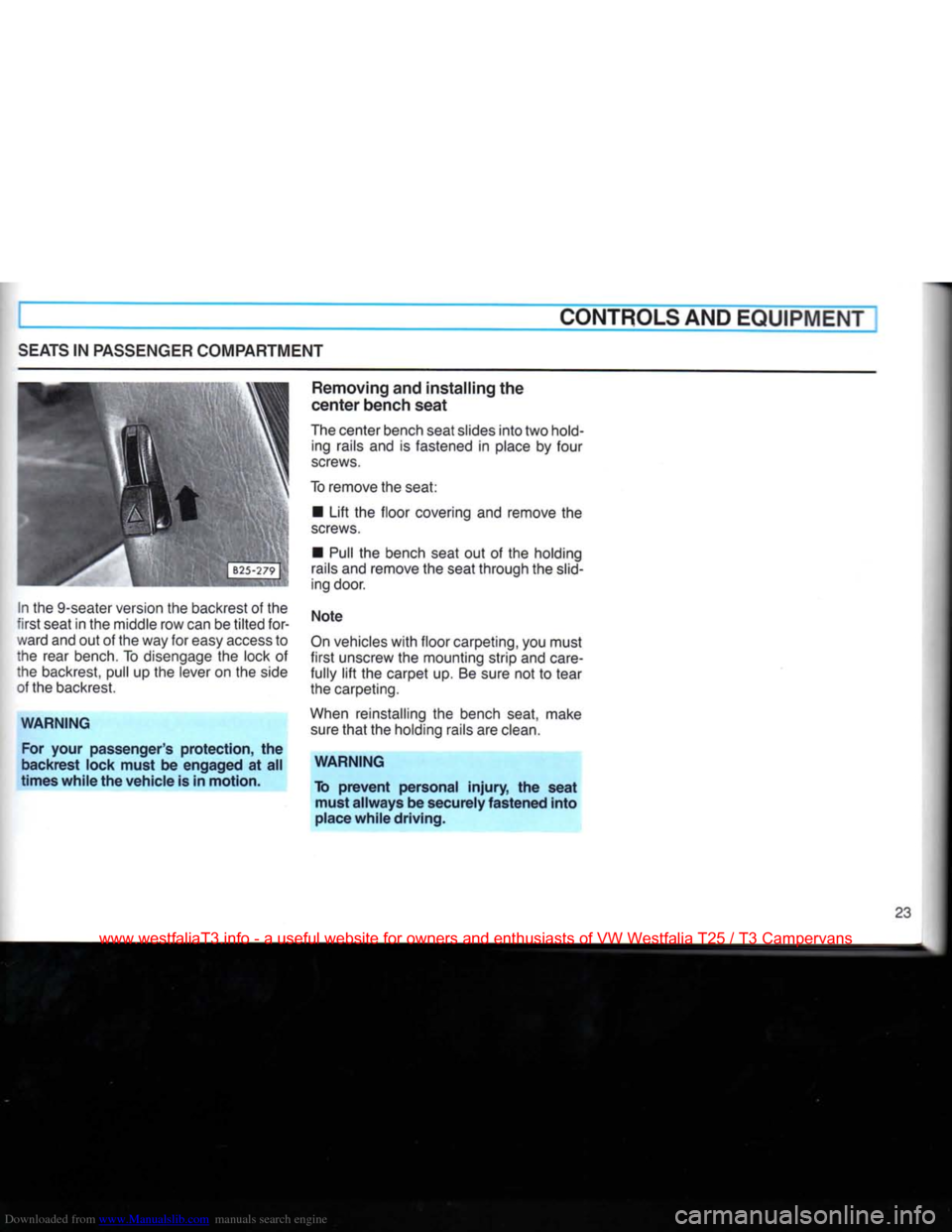
Downloaded from www.Manualslib.com manuals search engine
I
SEATS
IN PASSENGER COMPARTMENT CONTROLS AND
EQUIPMENT
In the 9-seater version the backrest of the
first
seat in the middle row can be
tilted
for
ward and out of the way for easy
access
to
the rear bench. To disengage the lock of the backrest, pull up the lever on the side
of the backrest.
WARNING
For
your
passenger's
protection,
the
backrest
lock
must
be
engaged
at all
times
while
the
vehicle
is in
motion.
Removing
and
installing
the
center
bench
seat
The center bench seat slides
into
two hold ing rails and is fastened in place by four
screws.
To
remove the seat: •
Lift
the floor covering and remove the
screws.
• Pull the bench seat out of the holding
rails and remove the seat through the
slid
ing door.
Note
On
vehicles
with
floor carpeting, you must
first
unscrew the mounting strip and care
fully
lift
the carpet up. Be sure not to tear
the carpeting.
When reinstalling the bench seat, make sure
that
the holding rails are clean.
WARNING
To
prevent
personal
injury,
the
seat
must
allways
be securely
fastened
into
place
while
driving.
23
www.westfaliaT3.info - a useful website for owners and enthusiasts of VW Westfalia T25 / T3 Campervans